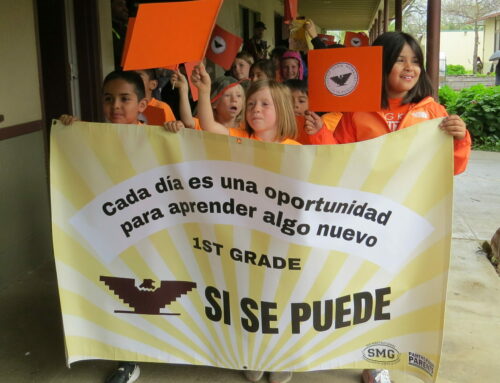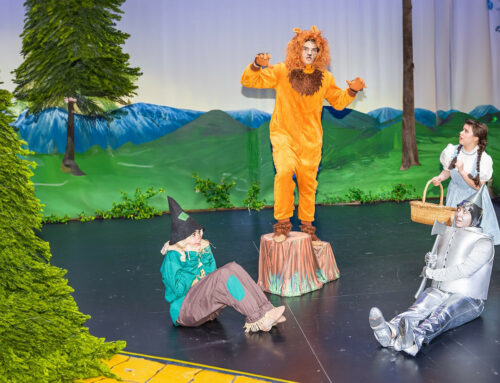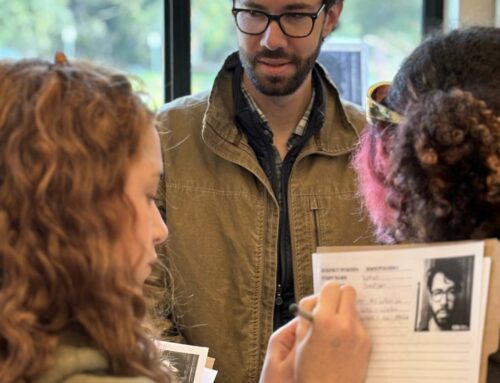Students, teachers and staff pleased with successful results after becoming an engineering academy
Published in the June 7 – June 20, 2017 issue of Morgan Hill Life
By Marty Cheek

Photo courtesy Paradise Valley Engineering Academy
Second/third grade teacher Rachel Marquardt tastes green eggs and ham after the students were read from the book by Dr. Seuss.
The challenge: Design and build a device to help explorers cross an ice field with multiple ravines.
At San Jose’s Tech Museum in April, the students from Paradise Valley Engineering Academy participating in the Tech Challenge won awards for “Best Teamwork and Collaboration,” “Best Team Safety,” and “Outstanding Engineering Journal.” The students and teachers celebrated recently when the school received recognition for receiving three awards out of 21 presented to schools throughout the Bay Area. The recognition spotlights Paradise Valley students’ ability to learn through a project-based style of classroom involvement.
“The students and teachers have embraced this (type of academics),” said Paradise Valley Principal Swati Dagar. “Teachers are being ‘engineers’ and are role models as engineers for students. It’s not just they’re going to solve a problem. It’s the process of solving a problem that is developing their Common Core critical thinking skills.”
Some parents expressed concern when early in 2016 the Morgan Hill Unified School District began the process of turning Paradise Valley Elementary School into Paradise Valley Engineering Academy. They feared the kindergarten through fifth-grade students might not be able to handle the challenges of an engineering-focused learning environment.
After the school year began in August, the transition toward engineering moved smoothly. The students feel proud they have proven themselves competent in the engineering project-based style of learning. Kindergartners work with robotics to solve problems. First-graders use Chromebooks to create Google documents and presentations. Fifth-graders learn about potential and kinetic energy working in teams to create “roller coasters” using only stiff paper, tape and a marble. Guest speakers visit from high-tech companies in the Silicon Valley, such as a team of IBM engineers recently coming to a class to talk to second-graders.
“The kids love it. The enthusiasm they had is out of this world,” Dagar said. “They have embraced this as part of their learning.”
Learning through doing things together as a team serves as an important component of classroom work for the students, said Sabrina Grant, a fifth-grade teacher at Paradise Valley.
“One of the main focuses we wanted the students to do is hands-on projects,” she said. “When they are using their hands, they are getting dirty and figuring things out with real-life experience. We’re getting the students to integrate math and science and reading and language arts all into one where you have a cumulative project that you’re presenting at the end of the process.”
Paradise Valley students learn all the subjects learned at traditional elementary schools. The difference is that the learning is incorporated into the engineering design process. Students discover the process of asking questions, imagining solutions to problems, and creating original ways to improve on the solution. They are encouraged to experiment and learn from mistakes. Taking risks through trial and error gives them feedback from failure, which leads to success in finding new ways to solve a problem.
“I was excited from the beginning of the transition, although somewhat overwhelmed with the task of learning all the new curriculum and the set-up for each of the engineering lessons because it’s a lot of work,” Grant said. “But the pay off has been ten-fold. To see the students thinking and their level of academic conversation when we’re doing an engineering project — the students have learned how to collaborate and work as a team and use scientific method and the engineering process.”
Paradise Valley fifth-grader Zackary Reynolds described how he and his fellow classmates recently learned how to protect the planet’s water supplies from contamination.
“We’re learning how to remove oil from water so we can learn how to keep the Earth’s environment safe so that we can survive,” he said.
Reynolds’s favorite project during the year was the paper roller coaster he built with fellow students to discover how energy can be stored in an object.
“It was my favorite project because we got to work with a group to create something,” he said. “It was fun.”
Fifth-grader Claire Tomasco observed about the transition: “In the other years it was just basic information. But when they turned it into an engineering academy, you get deeper into that one specific subject. You can learn more and get a better education.”
Noah Gaxiola, a fifth grader, likes the fact that engineering integrates various subjects such as science, social studies, writing and math.
“It has a bunch of different subjects in it,” he said. “Recently, we tried to prevent the oil from going around the places and we needed to be environmental engineers and save the river from overflowing with oil. I think the students really like it because it’s fun and very educational for all subjects, not just engineering.”
The Paradise Valley students are learning 21st century skills to help them find careers in 21st century jobs, Dagar said. The complexities of a global industrial civilization with more high-tech innovations and systems will require world citizens with engineering ability who can effectively work in teams, she said.
“I’m proud of all the growth the students and the staff have embraced in our learning community,” she said. “The way we have embraced learning in all subject matters, engineering does not just mean sitting behind a computer. Engineering for our students means solving a problem. It can be in any area, any field, and it can be in life. It just helps them break down a problem and find a solution. I am very proud of everyone here.”






